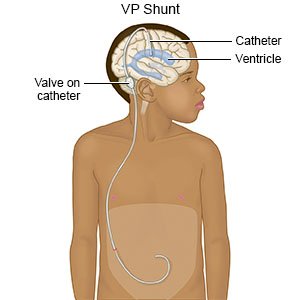Ventriculoperitoneal Shunt Placement for Hydrocephalus in Children
Medically reviewed by Drugs.com. Last updated on Apr 6, 2025.
Ventriculoperitoneal (VP) shunt placement is surgery to help remove extra cerebrospinal fluid (CSF) in your child's brain.
 |
DISCHARGE INSTRUCTIONS:
Call your local emergency number (911 in the US) if:
- Your child has sudden shortness of breath.
- Your child has trouble thinking clearly, is very fussy, or is hard to awaken.
Seek care immediately if:
- Blood soaks through your child's bandage.
- Your child's stitches or staples come apart.
- Your child suddenly starts vomiting.
- Your child is sleepier than usual.
Drugs used to treat this and similar conditions
Acetazolamide
Acetazolamide systemic is used for edema, epilepsy, glaucoma, hydrocephalus, hypokalemic periodic ...
Call your child's doctor if:
- Your child has a fever.
- Your child has a painful headache that does not go away with medicine.
- The incisions from surgery become swollen, red, more painful, or have pus coming from them.
- You have questions about your child's condition or care.
Care for your child's wound as directed:
You may need to carefully wash his or her wound with soap and water. Dry the area and put on new, clean bandages as directed. Change your child's bandages when they get wet or dirty.
Activity:
Your child may need to rest after surgery. Your child's healthcare provider will tell you when your child can return to his or her daily activities.
Follow up with your child's doctor as directed:
Write down your questions so you remember to ask them during your child's visits.
© Copyright Merative 2025 Information is for End User's use only and may not be sold, redistributed or otherwise used for commercial purposes.
The above information is an educational aid only. It is not intended as medical advice for individual conditions or treatments. Talk to your doctor, nurse or pharmacist before following any medical regimen to see if it is safe and effective for you.
Learn more about Ventriculoperitoneal Shunt Placement for Hydrocephalus
Care guides
Further information
Always consult your healthcare provider to ensure the information displayed on this page applies to your personal circumstances.
